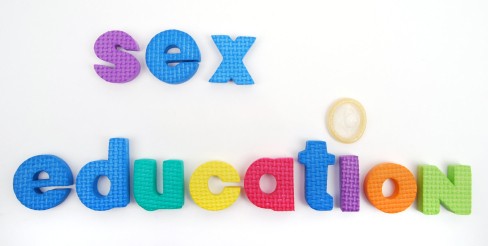
Warning: The following article includes offensive and graphic content.
A recent New York Times article titled “Teaching Good Sex,” fawns over comprehensive sex educator Al Vernacchio, a 47-year-old homosexual Catholic “Sex Scholar” who teaches English and human sexuality at a private high school near Philadelphia. In light of the fact that the Catholic Church teaches that homosexual acts constitute violations of divine and natural law, Vernacchio’s affirmation and embrace of homosexuality reveal that he affirms heresy and embraces sin.
Read the following excerpts to learn what Vernacchio talks about with high school students and to learn what many “comprehensive sex educators” would like to see in public schools:
“First base, second base, third base, home run,” Al Vernacchio ticked off the classic baseball terms for sex acts….”Give me some more,” urged the fast-talking 47-year-old, who teaches 9th- and 12th-grade English as well as human sexuality. Arrayed before Vernacchio was a circle of small desks occupied by 22 teenagers, six male and the rest female….
“Grand slam,” called out a boy (who’d later tell me with disarming matter-of-factness that “the one thing Mr. V. talked about that made me feel really good was that penis size doesn’t matter”).
“Now, ‘grand slam’ has a bunch of different meanings,” replied Vernacchio, who has a master’s degree in human sexuality. “Some people say it’s an orgy, some people say grand slam is a one-night stand. Other stuff?”
“Grass,” a girl, a cheerleader, offered.
“If there’s grass on the field, play ball, right, right,” Vernacchio agreed, “which is interesting in this rather hair-phobic society where a lot of people are shaving their pubic hair – “
“You know there’s grass, and then it got mowed, a landing strip,” one boy deadpanned, instigating a round of laughter. While these kids will sit poker-faced as Vernacchio expounds on quite graphic matters, class discussions are a spirited call and response, punctuated with guffaws, jokey patter and whispered asides….
[Vernacchio’s class] Sexuality and Society begins in the fall with a discussion of how to recognize and form your own values, then moves through topics like sexual orientation (occasionally students identify as gay or transgender, Vernacchio said…) safer sex; relationships; sexual health; and the emotional and physical terrain of sexual activity….
The lessons that tend to raise eyebrows outside the school, according to Vernacchio, are a medical research video he shows of a woman ejaculating – students are allowed to excuse themselves if they prefer not to watch – and a couple of dozen up-close photographs of vulvas and penises. The photos, Vernacchio said, are intended to show his charges the broad range of what’s out there. “It’s really a process of desensitizing them to what real genitals look like so they’ll be less freaked out by their own and, one day, their partner’s,” he said….
It was drummed into him as a human-sexuality master’s student, Vernacchio said, to never be explicit merely for the sake of being explicit: have a rationale for every last thing you say. Which occurred to me one day listening to him answer an anonymous question – there’s a box on the bookshelf where students can drop them – about whether a girl’s urge to urinate during intercourse might be a precursor to female ejaculation. He laid out a plethora of explanations for the feeling, everything from anxiety about having sex to a bladder infection to the possibility that the young woman was getting “some really good G-spot stimulation” and in fact verging on ejaculation.
“If kids are starting to use their bodies sexually, they should know about their potentialities,” Vernacchio told me later. “It’s O.K. that boys ejaculate, that’s totally normalized” – wet dreams have been standard fare for middle-school health class for decades – “but girls, gross! Girls will think they’re peeing themselves, and it’s really shameful.”…
As to whether his class encourages teenagers to have sex – a protest perennially lodged against even basic sex ed (though pretty firmly disproved by research) – Vernacchio said that he portrays sex in all its glory and complications. “As much as I say, ‘This is how orgasms work, and they’re really cool,’ I say there’s a lot of work to being in a relationship and having sex. I don’t think I have the power to make sex sound so enticing that kids are going to break through their self-esteem issues or body stuff or parental pressures or whatever to just go do it.” And anyway, Vernacchio went on, “I don’t necessarily see the decision to become sexually active when you’re 17 as an unhealthy one.” His goal is for young people to know their own minds, be clear about what they do and don’t want and use their self-knowledge to make choices….
To that end, he spends one class leading the students through a kind of cost-benefit analysis of various types of relationships, from friendship to old-school dating to hookups. When he asked his students about the benefits of hookups, the kids volunteered: “No expected commitment,” “Sexual pleasure” and “Guarding emotions,” meaning you can enjoy yourself without the messiness of attachment.
“Yep,” Vernacchio said, “sometimes a hookup is all you want.” Then he pressed them for drawbacks.
“You may not be able to control your emotions,” someone called out.
“O.K.,” Vernacchio said approvingly. “What else?”
“It’s confusing,” said the student-council vice president.
“Yeah,” Vernacchio said, explaining that two people may have different ideas about what it means to hook up, which is why communication is so important. (“If you can’t talk about it, you probably shouldn’t be doing it,” he says.)
“People saying, ‘Oh, she’s a slut,’ ‘Oh, he’s a man-whore,’ ” floated a boy who described himself to me as a “lonesome outcast” until 11th grade, when he finally started to make friends. “I guess for women it’s usually seen as more of a bad thing.”
“Right,” Vernacchio agreed, “but there’s pressure on guys too. Guys get the, ‘Oh, yeah, he’s a player,’ but what if you’re really not? And then you feel pressure to maintain that.”
Vernacchio rarely misses a chance to ask his students to examine gender bias in their sexual attitudes or behavior. The girl who “admitted” to liking sex as much as boys did said that Vernacchio’s consistent affirmation of the variety of sexual preferences (“Guys aren’t necessarily naturally hornier than girls – there’s a huge social piece of this,” he told the class) helped her shake her sense of deviance and shame….
During one class, he handed out a worksheet with the five senses printed along the top and asked the students to try and list sexual activities that optimized each. (There were examples to prod their thinking: under hearing, for instance, was “listening to your partner read an erotic story.”) [The purpose of the exercise] purpose was to open their minds to a broader sexuality.
Regarding the statistic that Vernacchio alluded to earlier – that 70 percent of women do not orgasm through vaginal penetration alone – one boy exclaimed when we talked, “That shocked me, a lot.” The other boys also told me they’d been in the dark about the mysteries of female sexual satisfaction. “I think I sort of knew where the clitoris was, but I didn’t know it was, like, under something,” one said. Another declared, “It’s almost like a wake-up call.” He paused. “To not just please yourself.”
The female students were nearly equally surprised. “I always thought, Is it weird that I don’t get an orgasm from, you know, just like vaginal penetration?” said a girl who’d had intercourse with one boy, though she’d had orgasms before that from being touched genitally. “It was comforting to hear that for most people it doesn’t happen. I mean, I’d heard it, but it was nice hearing it from Mr. V., who knows so much about it, and other people saying, ‘Yeah, yeah, that’s right.’ “
Not that information was always power for these young women. One girl said that while she could advise her boyfriend on how to increase her pleasure, she wouldn’t, because he’s “very insecure” about his lack of experience. Another estimated she’d had only two orgasms with her boyfriend of longstanding, each during intercourse, though she climaxes on her own through masturbation. Somehow, when she and her boyfriend “do anything, we just end up having sex,” she said, seeming both a little perplexed by the situation, and a little afraid to make waves.
Who gives oral sex to whom is common fodder for Vernacchio’s gender-parity conversations. All but one of the students told me they’d had it, but sometimes only once or twice, and the vast majority within monogamous relationships.
Although Vernacchio encourages students to think about fairness, he certainly doesn’t encourage a direct quid pro quo for oral sex – and the girls, the main givers, were not terribly enthused about being the recipients. “[My boyfriend] completely offered, and I did not want that,” one said. Another agreed: “It just creeps me out.” None were thrilled about performing it, either, and they seemed to be wrestling – in thought and deed – with why they continued to do so. “I do think girls like to take care of people,” the student-council V.P. mused, “and I know that just sounds horrible, like you should send me right back to the ’50s, but my mom is like the most liberal woman I know and still is so happy to make food for people. To some extent, women are just more people-pleasers than men.” One girl said she’d come up with “tricks” to make giving oral sex more enjoyable for her, and that she’d set “strict rules” for herself: “I only do it if they do something on me first, and it has to be below the belt.” And another said she doesn’t enjoy cunnilingus, but taking the personal is political to heart, she asked her boyfriend to do it anyway: if she was expected to service him orally, he should have to return the favor.
All the boys said that Vernacchio had increased their sensitivity to the girls. One recounted how in an effort to consider his girlfriend’s feelings he’d asked her if she was willing to give him oral sex – none of that pushing her head down in the heat of the moment – and she’d considered it for an excruciating hour. Or maybe it just felt like that. “Do you have to think about it this long?” he finally pleaded. Eventually, she agreed.
Pleasure in sex ed was a major topic last November at one of the largest sex-education conferences in the country, sponsored by the education arm of Planned Parenthood of Greater Northern New Jersey. One of sex educators’ big problems, [keynote speaker and sex educator Paul Joannides] told the New Jersey audience, is that they define their role as the “messengers of all the things that can go wrong with sex.”…
As much as Joannides criticizes his opponents on the right, [Joannides]also tweaks the orthodoxies of his friends on the left, hoping to spur them to contemplate how they themselves dismiss pleasure….
For instance, in addition to pulling condoms over bananas – which has become a de rigueur contraception lesson among “liberal” educators – young people need to hear specifics about making the method work for them. “We don’t tell them: ‘Look, there are different shapes of condoms. Get sampler packs, experiment.’ That would be entering pleasure into the conversation, and we don’t want that.”
While the conference attendees couldn’t have agreed more with Joannides about what should be taught in schools, much of the crowd thought he was deluded to imagine they could ever get away with it. Back in 1988, Michelle Fine, a professor of social psychology at the City University of New York, wrote an article in The Harvard Educational Review called “Sexuality, Schooling and Adolescent Females: The Missing Discourse of Desire.” In it, she included the comments of a teacher who discouraged community advocates from lobbying for change in the formal curriculum. If outsiders actually discovered the liberties some teachers take, Fine was told, they’d be shut down….
That more expansive sex education has to be done in code was something I came across repeatedly. A veteran advocate in the field gave me a short list of teachers to contact who might be willing to talk to me but then warned, “I don’t know if any of them are going to want to have what they’re doing out there.”
There you have it, friends. These are the kinds of ideas that typical comprehensive sex educators want to teach our children. They focus obsessively on affirming and facilitating unfettered teen sexual autonomy and pleasure. Comprehensive sex educators fervently seek to sever sex from any fixed moral system. They never explain precisely how explicit conversations with teens about sexual autonomy and pleasure will reduce the incidence of unintended pregnancy or sexually transmitted infections, nor do they provide proof that such conversations will reduce the numbers of teen pregnancies or STIs. What these kinds of conversations reveal is that the perverted legacy of sex researcher Alfred Kinsey, who “worked tirelessly to promote sexual liberation,” “undermine traditional morality,” and “soften the rules of restraint,” lives on in comprehensive sexuality education.
The sexual worldview of “Sex Scholars” like Al Vernacchio should provide sufficient justification for every Illinois lawmaker to oppose any bill that compels every school district to use comprehensive sex ed curricula.
Help expand our reach
by forwarding this email to like-minded family and friends.
Click HERE to make a donation to the Illinois Family Institute.























